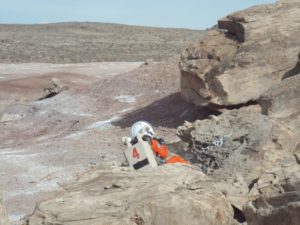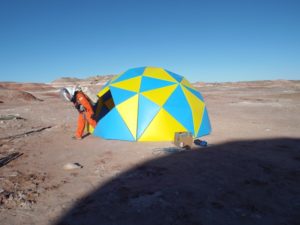Sol Journal – November 28th
Construction on Mars
We entered the airlock with little energy left. Three men and one woman. All with the same expression of tiredness on the faces. Three hours of working at the surface on Mars. For the first time we were building the two meters high dome in the spacesuits. Even though the material is plastic cardboard, we still spend “sweat and blood” by assembling the parts. Bulky space gloves made it even harder to work with the wires and small parts. We had to use extra tools, such as nippers, pliers. The edges of the helmet were stopping me to get a closer look at the components and joints, therefore sometimes I had blind spots. At that moment, I understood that construction on Mars would be the hardest EVA for astronauts, which led me to question “how to prepare for that?”
Let’s start with the astronauts. They have to be in a very good physical shape, which brings several important aspects. On the spaceship flying to Mars there should be progressive medical and exercise facilities to maintain health and stamina of the crew. Apart from that, the key role would be the quality of the food and vitamins supplements. Here at MDRS I experienced it, as never before. Firstly, yoga and physical activities always brings up more energy, makes the blood circulate, removes tension in muscles and congestion, clears head and gives fresh look. The exercise hours for me is recreational time, rather than a work or physical torture. The dehydrated food was difficult to process for my stomach, like chewing sand and trying to digest it. Don’t get me wrong we cook great food here, it tastes very nice, but my body tolerate it each day less and less. I judge by the skin condition because the skin is the mirror of the gut. Ideally, in the Mars missions each crew member will have specially designed diet and set of packed food with amount of all needed nutriments. And after few months living on Mars they will grow fresh vegetables and maybe even fish. I like the idea of using aquaponics systems. It is a large water tanks, in which lives fish and plants. The excrements of the fish provide food for the plants, and the plants clean the water from toxic fish waste products. Perfect union, where the three parties win: plants, fish and human. We also have such a system in the greenhouse, which will be running in the nearest future.
In addition to human factors, the equipment, hardware and software will play crucial role to build the station and expand a colony on Mars. 3D printers will be used widely to produce plastic and metal parts for the engineering use, medical tools and even a breeks made from Martian soil. The spacesuits should be different from the ones space agencies use now. Most likely, the mechanical counter pressure (MCP) suit will fit to “the construction on Mars” requirements. The MCP suit is when the body is compressed by tight garments except the head, which would be in standard gas-pressurized helmet for breathing. It should be a light, durable, puncture resistant, low leakage suit with excellent full-body flexibility. In this case, the construction work in the space suits will be restricted only by the amount of oxygen left in the backpack.
The experiment of building the domes at Mars Analogue station will help us to understand the difficulties, which Mars explorers will face in the future. Therefore, the more we try, the less we deluded.
















